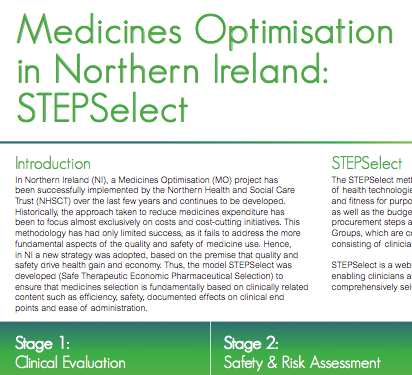Historically, the approach taken to reduce medicines expenditure has been to focus almost exclusively on costs and cost-cutting initiatives. This has had only limited success, as it fails to address the more fundamental aspects of the quality and safety of medicine use.
In conjunction with our collaborators, the STEPSelect programme (Safe Therapeutic Economic Pharmaceutical Selection) has been developed. This system ensures that medicines selection is fundamentally based on clinically related content such as efficacy, safety, documented effects on clinical end points and ease of administration. STEPSelect is a web based tool developed by Digitalis Mm Ltd, enabling clinicians and other health care providers and managers to comprehensively select and procure medicines and medical devices.
Transparent process
The STEPSelect method looks in first instance at clinical features of health technologies. At a later stage of the evaluation, product quality and fitness for purpose are assessed (the so-called risk assessment stage) as well as the budget impact of a health technology and appropriate procurement steps and routines. Evaluations are carried out by Expert Groups, which are composed on the basis of a multidisciplinary nature consisting of clinicians, pharmacists, nurses and other staff as appropriate. The STEPSelect method has been used for a number of drug classes including erythropoietin stimulating agents and granulocyte colony stimulating factors and has now been extended to include dressings and medical and surgical devices. The outcomes of the process are used to produce guidance and to assist in formulary management. This can then be used to inform electronic decision support at the point of prescribing.
Stage 1: Clinical Evaluation
- Literature evidence compiled by professional editorial network of Digitalis
- Review evidence supplied by Pharmaceutical Industry, additional to the literature review (STEPSelect) and best evidence
- Assign relative weights to each selection criteria and scores to each product
- Ranking of chemical entities to proceed to Stage 2
Stage 2: Safety and Risk Assessment
- Product samples obtained from Industry
- Assessed using modified versions of national QC and Risk Assessment tools for Medicinal Products: Product Quality and Fitness for Purpose (PQFFP) and Medicines Error Potential Assessment (MEPA)
- PQFFP (Pass/Fail); MEPA (Low, Medium, High)
- Ranking of chemical entities and MEPA scores to proceed to Stage 3
Stage 3: Budget Impact Analysis
- Annual usage data obtained to allow comparison of products within the same class
- Ranking of chemical entities to proceed to Stage 4
Stage 4: Contract & Guidance
- Guidance produced to inform the service of products suitable for prescribing first line
- Relevant contracts put in place
Efficiency gains
In NI the STEPSelect technology has been applied to procurement of medicines in many different therapeutic groups such as statins, erythropoietin stimulating agents (ESA’s) and the use of biologicals in rheumatoid arthritis. Results with the method have invariably been positive in terms of support by clinicians and quality and cost reductions of prescribing, often in the region of 20-25% per therapeutic group.
Benefits:
- Reduced medicines related adverse events
- Improved Quality: Drug selection based on safety & efficacy, then cost
- Improved Efficiency: Cost-effective drug selection, reduced stockholding and reduction of out of date stock
- Robust, transparent, defensible process
Interactive website:
- Tablet devices for Expert Group members
- Project mentor
- Project key for limited access for special target groups
- e-Sessions to highlight choices for special interest groups
- Comprehensive stakeholder input via these interactive mechanisms
Summary:
- Supports a clinical driven procurement process
- Process is based on the principles of quality and safety
- Supports guidance and formulary development and maintenance
- Maximises health care resource utilisation
- A key component of Medicines Optimisation

